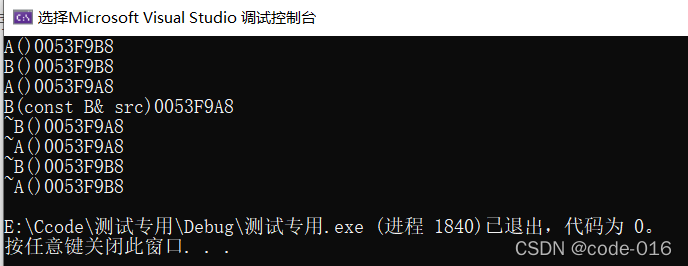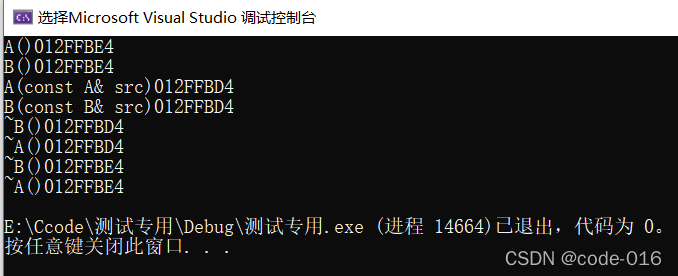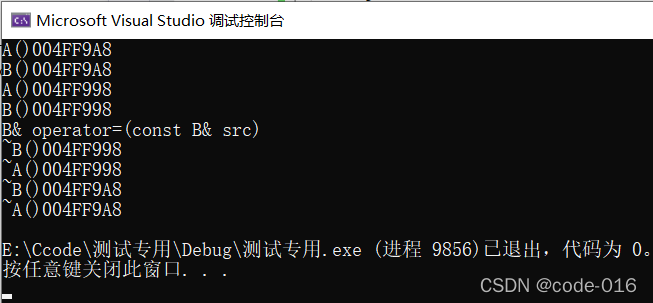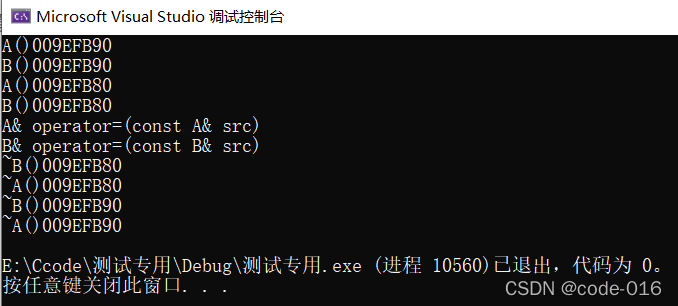一、构造/析构顺序及继承性
|
1 2 3 4 5 6 7 8 9 10 11 12 13 14 15 16 17 18 19 20 21 22 23 24 25 26 27 28 29 |
class A { private: int _a; public: A(int a = 0): _a(a) { cout << "A()" << this << endl; } ~A() { cout << "~A()"<< this <<endl; } };
class B : public A { private: int _b; public: B(int b): _b(b), A() { cout << "B()" << this << endl; } ~B() { cout << "~B()"<< this <<endl; } }; |

结论:
1.构造顺序:先构造基类,后构造派生类
2.析构顺序:先析构派生类,后析构基类
二、拷贝构造的继承性
|
1 2 3 4 5 6 7 8 9 10 11 12 13 14 15 16 17 18 19 20 21 22 23 24 25 26 27 28 29 30 31 32 33 34 35 36 37 |
class A { private: int _a; public: A(int a = 0): _a(a) { cout << "A()" << this << endl; } A(const A& src): _a(src._a) { cout << "A(const A& src)"<< this << endl; } ~A() { cout << "~A()"<< this <<endl; } };
class B : public A { private: int _b; public: B(int b): _b(b), A() { cout << "B()" << this << endl; } B(const B& src): _b(src._b) { cout << "B(const B& src)" << this << endl; } ~B() { cout << "~B()"<< this <<endl; } }; |

结论:
1.先调用基类缺省的构造函数,后调用派生类的拷贝构造函数
2.若派生类没有缺省构造函数A(),就会报错
疑惑:如何去调用基类的拷贝构造而不是缺省构造
|
1 2 3 4 5 6 7 8 9 10 11 12 13 14 15 16 17 18 19 20 21 22 23 24 25 26 27 28 29 30 31 32 33 34 35 36 37 38 39 40 41 42 43 44 45 46 |
#include<iostream> using namespace std;
class A { private: int _a; public: A(int a = 0) : _a(a) { cout << "A()" << this << endl; } A(const A& src) : _a(src._a) { cout << "A(const A& src)" << this << endl; } ~A() { cout << "~A()" << this << endl; } };
class B : public A { private: int _b; public: B(int b) : _b(b), A() { cout << "B()" << this << endl; } B(const B& src) : _b(src._b), A(src) //发生赋值兼容规则(切片) { cout << "B(const B& src)" << this << endl; } ~B() { cout << "~B()" << this << endl; } }; int main() { B b(10); B b1(b); return 0; } |

结果:
将B类型src传递给A类型的A(const A& src)拷贝构造函数,发生了赋值兼容规则(切片现象)
三、赋值重载不具有继承性
|
1 2 3 4 5 6 7 8 9 10 11 12 13 14 15 16 17 18 19 20 21 22 23 24 25 26 27 28 29 30 31 32 33 34 35 36 37 38 39 40 41 42 43 44 45 46 47 48 49 50 51 52 53 54 55 56 57 58 59 60 61 62 63 |
#include<iostream> using namespace std;
class A { private: int _a; public: A(int a = 0) : _a(a) { cout << "A()" << this << endl; } A(const A& src) : _a(src._a) { cout << "A(const A& src)" << this << endl; } A& operator=(const A& src) { if(this != &src) { _a = src._a; cout << "A& operator=(const A& src)" << endl; } } ~A() { cout << "~A()" << this << endl; } };
class B : public A { private: int _b; public: B(int b) : _b(b), A() { cout << "B()" << this << endl; } B(const B& src) : _b(src._b), A(src) //发生赋值兼容规则(切片) { cout << "B(const B& src)" << this << endl; } B& operator=(const B& src) { if(this != &src) { _b = src._b; cout << "B& operator=(const B& src)" << endl; } } ~B() { cout << "~B()" << this << endl; } }; int main() { B b1(10); B b2(20); b1 = b2; return 0; } |

结论:默认情况下仅仅调用了派生类的对象的赋值重载,并未调用基类的赋值重载。
解决方案:
|
1 2 3 4 5 6 7 8 9 10 11 12 13 14 15 16 17 18 19 20 21 22 23 24 25 26 27 28 29 30 31 32 33 34 35 36 37 38 39 40 41 42 43 44 45 46 47 48 49 50 51 52 53 54 55 56 57 58 59 60 61 62 63 64 |
#include<iostream> using namespace std;
class A { private: int _a; public: A(int a = 0) : _a(a) { cout << "A()" << this << endl; } A(const A& src) : _a(src._a) { cout << "A(const A& src)" << this << endl; } A& operator=(const A& src) { if(this != &src) { _a = src._a; cout << "A& operator=(const A& src)" << endl; } } ~A() { cout << "~A()" << this << endl; } };
class B : public A { private: int _b; public: B(int b) : _b(b), A() { cout << "B()" << this << endl; } B(const B& src) : _b(src._b), A(src) //发生赋值兼容规则(切片) { cout << "B(const B& src)" << this << endl; } B& operator=(const B& src) { if(this != &src) { *(A*)this = src; //将调用基类赋值重载 _b = src._b; cout << "B& operator=(const B& src)" << endl; } } ~B() { cout << "~B()" << this << endl; } }; int main() { B b1(10); B b2(20); b1 = b2; return 0; } |


